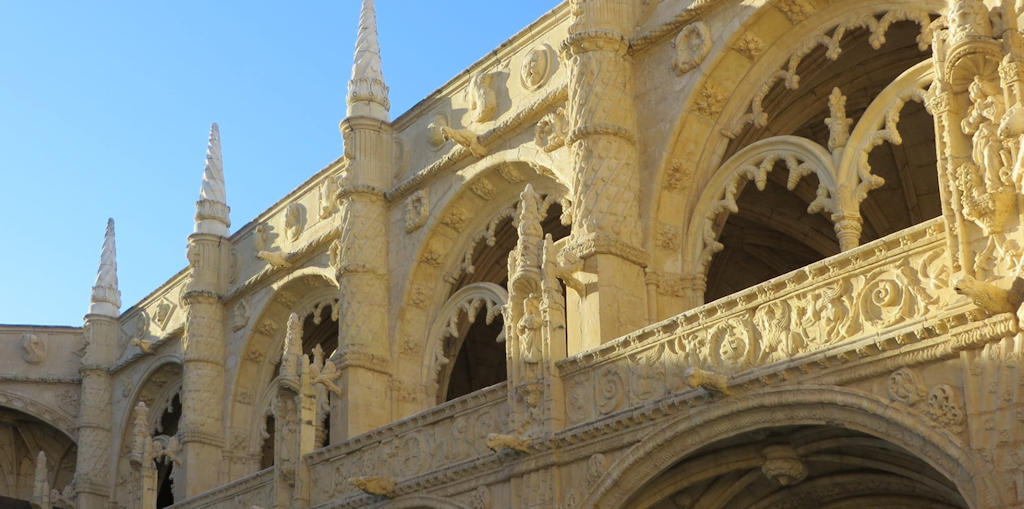Key Features of Manueline Art and Architecture:
- Intricate Stone Carvings: One of the defining features of Manueline art and architecture is the exquisite stone carvings that adorn facades, columns, and portals. Known as "lacework," these carvings showcase a remarkable level of detail and craftsmanship. They often feature motifs such as ropes, knots, shells, seaweed, and other maritime symbols, paying homage to Portugal's seafaring heritage.
- Maritime Imagery: As a celebration of Portugal's exploration and naval achievements, Manueline art incorporates abundant maritime imagery. Sculptures and decorative elements depict anchors, ropes, ships, sea monsters, and other nautical motifs, symbolizing the nation's global reach and maritime power.
- Manueline Windows: Manueline architecture is distinguished by its exquisite windows, which are often referred to as "Manueline windows." These windows are characterized by intricate tracery, curvilinear shapes, and flamboyant designs. They showcase the mastery of stone carving and provide a visual feast of intricate patterns and delicate details.
- Blend of Styles: Manueline art and architecture exhibit a fascinating fusion of influences. It draws from the late Gothic style, incorporating pointed arches, ribbed vaults, and spires. It also integrates elements from the Renaissance, such as classical motifs and a fascination with naturalism. Furthermore, Manueline art incorporates subtle hints of Moorish influence, seen in the intricate geometric patterns and interlacing designs.
Lisbon.vip Recommends
Notable Examples of Manueline Art and Architecture in Lisbon:
- Jerónimos Monastery (Mosteiro dos Jerónimos): Situated in Lisbon, the Jerónimos Monastery is one of the most iconic and splendid examples of Manueline architecture. This UNESCO World Heritage site was constructed to commemorate Vasco da Gama's successful voyage to India. The monastery's elaborate facade showcases a profusion of Manueline motifs, including delicate lacework, maritime elements, and intricately carved figures. The interior features magnificent vaulted ceilings and the tranquil beauty of the cloister.
- Belém Tower (Torre de Belém): Located on the banks of the Tagus River in Lisbon, the Belém Tower is an imposing fortress and a testament to Portugal's maritime heritage. Built in the early 16th century, it served as a defensive structure and a ceremonial gateway to the city. The tower exhibits Manueline characteristics, including intricate stonework, maritime symbols, and Manueline windows. It stands as an enduring symbol of Portugal's exploration and is designated as a UNESCO World Heritage site.
- São Roque Church (Igreja de São Roque): The São Roque Church is an architectural gem nestled in the heart of Lisbon. Although its exterior may appear relatively simple, the interior boasts an impressive display of Manueline and Renaissance influences. The Chapel of St. John the Baptist, often referred to as the "jewel of São Roque," showcases exquisite Manueline-style decoration. Intricate gilded woodwork, elaborate frescoes, and ornate altarpieces adorn the chapel, creating a sumptuous and visually captivating space.
- Monastery of São Vicente de Fora (Mosteiro de São Vicente de Fora): Situated near the Alfama district, the Monastery of São Vicente de Fora combines Manueline and Mannerist architectural elements. Built in the 16th century, the monastery features a stunning facade with intricate stone carvings, including delicate lacework and maritime motifs. The interior houses beautiful chapels and an impressive cloister adorned with azulejo tiles, showcasing scenes from Portuguese history. From the monastery's rooftop, visitors can enjoy panoramic views of Lisbon.
Legacy and Significance:
Manueline art and architecture left a lasting legacy in Portuguese culture and beyond. It represents a unique fusion of artistic influences, symbolizing Portugal's remarkable exploration and maritime achievements. Manueline elements can still be found in various architectural structures throughout Portugal, serving as reminders of the nation's glorious past. The elaborate stone carvings, intricate detailing, and maritime motifs of Manueline art continue to inspire awe and admiration, reflecting the artistic brilliance of this remarkable period in Portuguese history.Manueline art and architecture hold a special place in Portugal's cultural heritage. The style's ornate stone carvings, maritime motifs, and unique blend of influences evoke a sense of wonder and admiration. The exquisite examples of Manueline architecture, such as the Jerónimos Monastery, Belém Tower, and Batalha Monastery, stand as testaments to Portugal's illustrious past. Through their intricate detailing and grandeur, they continue to mesmerize visitors and provide a glimpse into the rich artistic and architectural legacy of Manueline art.



